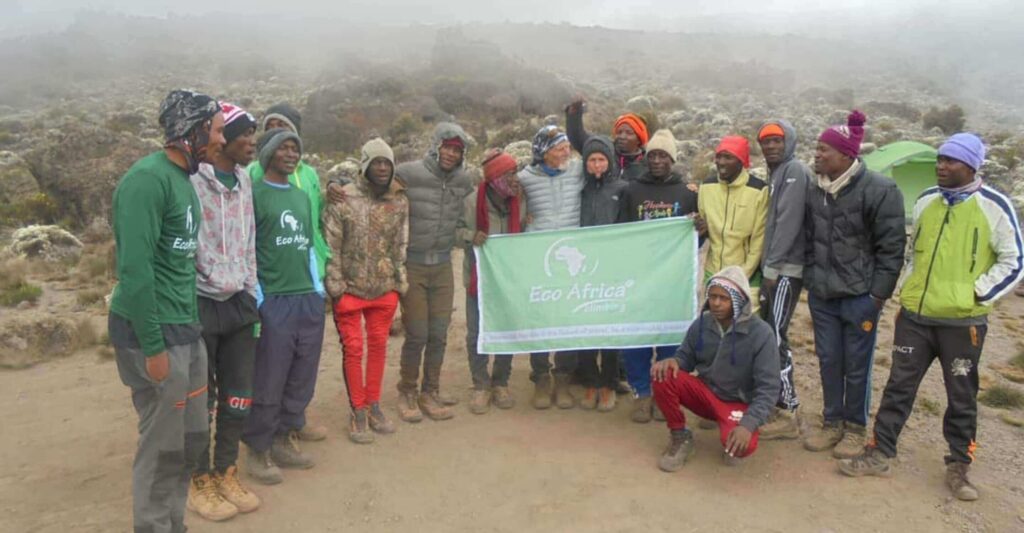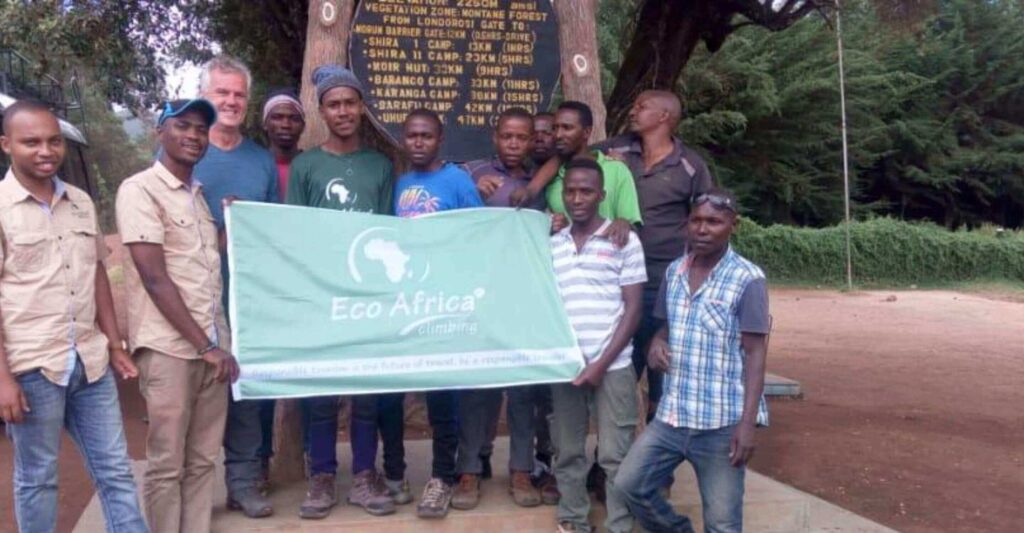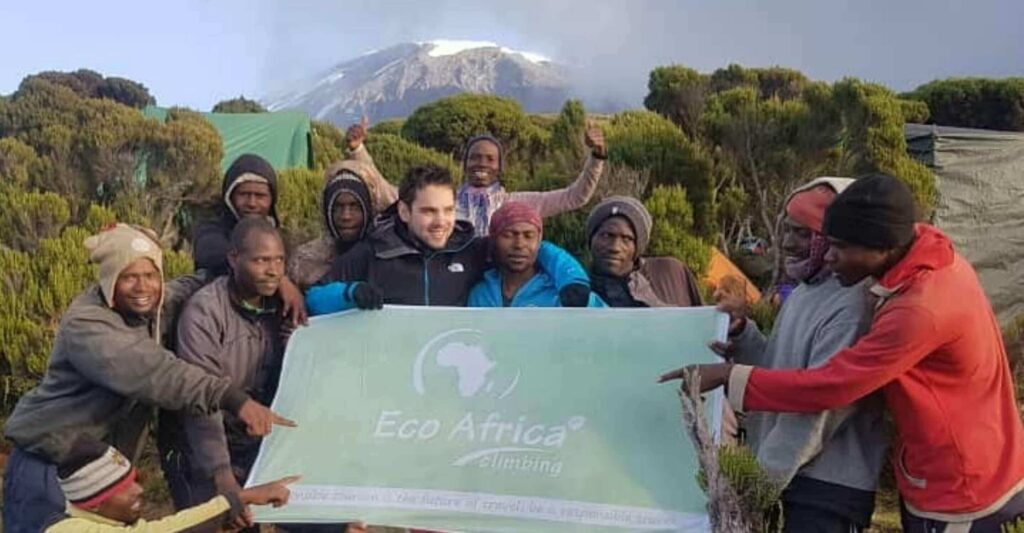KILIMANJARO FITNESS AND TRAINING
How do I Train to Climb Kilimanjaro?
Climbing Mount Kilimanjaro is a physical undertaking, so you should prepare yourself accordingly with a Kilimanjaro Fitness and Training program. Being in good shape is essential in many respects. Muscular, conditioned legs make walking uphill and downhill for sustained periods easier. General aerobic fitness allows the body to function efficiently with less oxygen. And a fit body is more likely to withstand the stress of consecutive days of hiking and camping. Finally, a positive mental attitude can work wonders for you when fatigue and doubts arise.
How hard is it to climb Kilimanjaro? That’s a difficult question because some people don’t train much and fare very well, while others engage in a disciplined training program and succumb to the altitude in a few days. We’ve heard marathon runners tell us that climbing Kilimanjaro is the hardest thing they’ve ever done. The best advice we can give is to train adequately, as described below, and get yourself in the best possible hiking shape. The mountain is a big unknown, and you won’t know how you will react until you are there. The best exercise that you can do to prepare for Mount Kilimanjaro is hiking.
Things you need to know before Climb Kilimanjaro:
- You will be hiking slowly, but ‘slowly’ at altitude can feel more like a run at sea-level
- You need to be able to walk 6-8 hours a day, then do it all over again the next day, and the day after
- Summit night/day can be 10+ hours on your feet
- The trails can be steep, rocky and uneven.
- Mental stamina and mindset is essential
While fitness alone will not help you acclimatize to the altitude, being in the best shape possible will have the following benefits:
- Ability to recover quickly from the day’s exertion and be energized for the next day’s hiking
- Improved oxygen delivery to the muscles
- Solid legs for the steep (both uphill and downhill) sections
- Improved balance and flexibility to reduce injury
- Enjoyment of your surroundings.
Don’t forget:
- Wear your hiking boots during practice hikes, at the gym or around the house. Especially new boots, you want them well broken-in. Experiment with different sock combinations.
- Practice wearing your daypack (put some weight in it) to get your shoulders and back used to hike with it
- Practice layering your clothes: how do the layers fit, and getting them on and off quickly
- Hiking poles: if you’re planning to use them on the mountain.
Kilimanjaro has no best fitness program, and how much training you’ll need is unique to your situation. If you’re very fit or going to the gym regularly, you might need to add some hiking trails (preferably uphill). If you’re unfit, you may need to start at the beginning.
Our Top Recommended Ethical Kilimanjaro Climbs
Ethical Kilimanjaro via Northern Circuit Route 9 Days
The Northern Circuit route is one of the best routes on Kilimanjaro.The route approaches Mount Kilimanjaro from the west….
From USD $3250
Ethical Kilimanjaro via Lemosho Route 8 Days
The Lemosho route is one of the newer routes on the mountain and a superb choice for your climb, It is our preferred route…
From USD $2950
Ethical Kilimanjaro via Machame Route 7 Days
Machame (“Whiskey”) Route is also known as the “Whiskey” route, the Machame route is now the most popular route on the …
From USD $2650
Kilimanjaro Fitness and training
Any Kilimanjaro fitness program will depend on your current exercise routine, injury status, and fitness levels. You don’t need superhuman physical performance levels; with enough time (if your doctor agrees), most healthy people can get in shape for Kilimanjaro.
It’s a case of getting your body used to the specific demands of the trek.
The main aspects you’ll need to work on are:
- Endurance & cardiovascular fitness
- Leg, core & back strength
- Flexibility and balance (stretching)
- Get out and hike, preferably incorporating rough trails and hills.
- Mental stamina
Tips for a Successful Kilimanjaro Fitness Program
Please keep it simple & sustainable.
- Pick an exercise you enjoy. If you love biking, get out on your bike; if running’s your thing, then do that. The important thing is whatever exercise you do, make it progressive, so you build up your stamina and keep pushing yourself.
- If you’re short of time, consider high-intensity interval training.
- You can do anything that improves the work capacity of muscles and your cardiovascular system.
Use daily life events as training opportunities.
In addition to your more formal training program, find other opportunities as you go about your day. Do you have a dog? Put on a daypack with 20lbs when you take Fido for his daily walk. Take the stairs, mow the lawn, anything that gets you moving.
In the Mountain Hills or the Gym
- Wherever possible, put on your boots and daypack, and get outside. Hiking up and down hills over rough terrain will give you an idea of what it’s like on the mountain. Increasing the duration of your walks will help to prepare you for being on your feet for many hours at a time.
- No access to hills? Crank the treadmill onto a steep incline, or use the stair master. Wear your daypack and hiking boots, and practice.
Make it Progressive & Listen to your body.
- You want your training to be challenging and prepare your body and mind. But you don’t want to burn yourself out. Prepare your training program to be progressive, so you keep making gradual gains in your fitness process.
- If you’re unsure how to prepare your training program, consider consulting with a personal trainer. You can also buy the online Kilimanjaro Training Program from Basecamping Training to help you out.
The Importance of Your Body Rest & Recovery
- There’s a delicate balance between pushing yourself hard and too hard. Muscle soreness, injury, poor sleep, and fatigue can indicate that you are going too hard, too soon.
- Start training for your Kilimanjaro climb early enough (3-6 months). Good training is not an overnight success; it’s the sustained process over time.
Prevent Plateaus
- Switch up your training every 3-4 weeks and incorporate something different. If you do the same thing all the time, your body will adapt to it, and you’ll need to go harder for the same benefit. Switching to a different workout routine presents new challenges for your body to adapt.
- Note: this is why it’s important not to “just walk” for your Kilimanjaro preparation. Your body will adapt to walking at sea level quite quickly unless you’re doing multiple hours of hiking per day.
Taper your Training a few weeks before going to Kilimanjaro
- About two weeks out from the start of your climb, keep up the training but lower the intensity. You’ll want to be fresh and well-rested at the beginning of your climb, and you don’t want to risk injury.
Endurance and Cardiovascular Fitness
Endurance or stamina refers to the body’s fundamental ability to maintain a high work rate for long durations. Endurance training is an organized method to enhance your metabolism or, in other words, to increase oxygen efficiency and energy production in your muscles.
- Biking, swimming, jogging, stair master, elliptical – build up to 60-90 minutes of sustained work at around 70% of your maximum heart rate.
- High-Intensity Interval Training – use if you’re short on time and to provide a different training stimulus.
- Wear your weighted daypack and hiking boots whenever possible, and try to get out for some strenuous hikes, preferably with some elevation gain.
You can also incorporate some specific altitude training protocols to help you get accustomed to the lack of oxygen on the mountain.
Strength Training
- What is strength? The body can perform the most work with the least amount of effort. Remember, you’ll have the altitude to contend with, so you want your body to be as efficient as possible at performing the “work” (trekking) required.
Resistance training predominantly trains the anaerobic (without oxygen) energy production systems.
- Work on your lower body (leg) strength – squats, lunges, anything that targets the large muscles in your legs.
- Build your core strength for good balance on uneven terrain
- Back and upper body strength for carrying your daypack
You’ll need strong legs to power you up the mountain, and the downhill sections can be challenging on your hips, knees, and thighs. A good strength training program will help the larger muscle groups build strength and strengthen the smaller, stabilizing muscles around the joints to reduce injury.
You don’t need to go full-on bodybuilder strength training, but incorporating resistance training 2-4 times a week will pay dividends later. If you are not experienced with weight training, we recommend consulting a personal trainer.
Stretching, Flexibility & Yoga
- It’s easy to ignore flexibility when doing a lot of cardio or strength training. Stretching your muscles before and after exercise reduces injury, and it makes you more balanced and helps the muscles recover.
- Incorporating some yoga into your program helps with your breathing techniques, promotes good posture and helps you to stay calm and focused on the challenge ahead.
Breathing Techniques
- Learning to control your breathing is very important when you hike in the thin air. Shallow breathing and hyperventilation don’t allow you to take in enough oxygen and can increase your body’s stress response. Be mindful of your breathing and learn to take long, slow, deep breaths.
- Using yoga, meditation, or specific breathing techniques can help with your ability to listen to your body. Tuning into your body’s needs such as hunger, thirst, heart rate, aches, and pains means you’ll know quickly if something’s wrong.
Injury Prevention & Existing Injuries
Most of us have an odd sore knee, tight hip or weak shoulder. Knowing your current limitations (check with your doctor for any injuries you suspect) allows you to prepare better.
- Ask your doctor or physiotherapist about a knee brace, particularly for downhill sections, if you’ve got poor knees.
- Hire a good personal trainer to devise a program to strengthen your weak points
- Soft-tissue work or sports massage can help free up tight muscles in certain areas.
- Prevent injury by warming up and cooling down before and after intense exercise
On the Mountain
- Choose the longest route possible for the best acclimatization protocol; see our Kilimanjaro best Route.
- Take it slow and steady: conserve your energy; there’s no rush.
- Stay hydrated, and eat regularly.
- Use hiking poles to help you balance on uneven terrain.
- Treat ‘hotspots’ on your feet to prevent them from turning into blisters.
Learn the Rest-Step
- The “rest step” is a hiking technique that has you drop your heel with every step, completely straightening your leg. This puts the weight on your skeleton and gives your muscles a chance to relax for a moment.
- And most importantly: tell your guide immediately if you feel unwell, have a headache, nausea or are suffering pain.
Mental Stamina
Trekking Kilimanjaro is a mental challenge and requires perseverance and determination. The long hours of hiking, effects of altitude, and sleeping in a cold tent can all take their toll.
How can you ‘train’ mental stamina?
- You remember your “why”. Why did you choose Kilimanjaro? Are you raising money for a charity? Perhaps it’s to push your physical capacity or a lifelong dream. Either way, keep your “why” in mind
- Mindfulness and meditation. There are plenty of resources explaining the benefits to the mind and body of meditation, one of which is improving your mental resolve.
- Complex training: pushing yourself through a previous ‘limit’ can show you what you’re capable of. Perhaps you’ve achieved a personal best of some sort.
- Confidence, but not over-confidence. Achieving milestones that you set for yourself can increase your confidence in handling challenging situations. Overconfidence can cause laziness and complacency.
- Draw on your own experiences. Remember some challenging situations you’ve overcome, and remind yourself that you can do this.
- Be informed: read up as much as you can about the challenge you are undertaking, build up knowledge about the mountain and yourself.
- One step, one breath, one activity, one achievement at a time.
See our 12 Weeks Kilimanjaro Fitness and Training Program, which can help you start your Kilimanjaro Training.
Nutrition
- We provide you with well-balanced, nutritionally dense meals and cater to most dietary requirements on the mountain. During your training, it’s essential to follow a healthy nutritional plan for optimal results that aligns with your goals. Read more on Food on Kilimanjaro climb.
To Sum Up
Anyone in good health (if your doctor agrees) can get fit enough to climb Mt Kilimanjaro. There’s no “magic bullet” or secret to training for Kilimanjaro, and it’s a matter of putting the work in and gradually building up your capacity.Try not to compare yourself to others. Many people in sub-optimal physical condition have achieved the summit, and many athletes have failed. The effects of altitude are a great equalizer. Be your best self, train to be in your best physical shape. If in doubt, seek professional help from a qualified personal trainer or your physician.
Questions? Contact us today, or Book Now your Kilimanjaro adventure of a lifetime!


